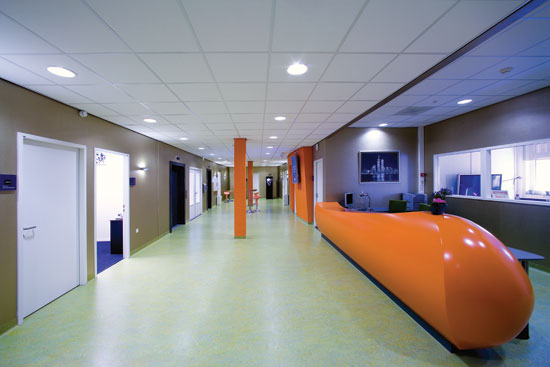The Value of Stone Wool Acoustical Ceilings
Sustainability: Green Building Contributions of Stone Wool Acoustic Ceilings
Earlier we identified the problems that too much or unwanted sound can create for people in a building. By comparison, the most important contribution to any sustainable building from an acoustic ceiling tile is the creation of sustainable working, learning, and healing environments through acoustic comfort. This has become recognized and formalized in the U.S. Green Building Council's (USGBC) LEED® rating system which contains a number of areas where ceilings can contribute to a higher LEED rating. While acoustic comfort will likely be the biggest contributor, there are also other areas worth noting that stone wool ceiling tiles can contribute to a green building design. This is true in both of the current versions of LEED that are in use, namely, LEED 2009 and LEED version 4 (v4).
Energy and Atmosphere
When designing an energy-efficient building, there is a tendency to focus on things like insulation and windows, but ceiling systems can also play a role in effective energy conservation. By using a ceiling system that has higher levels of light reflectance, less artificial light may be needed. Stone wool ceilings offer superior light reflection and diffusion. Typical acoustical ceilings have a Light Reflectance (LR) rating of 0.75, meaning that they reflect 75 percent of the light striking its surface. Most white stone wool ceilings reflect between 83-86 percent of available light. They have a homogenous surface without any visible holes or perforations, and their high diffusivity limits hot spots and glare for increased comfort. Combined, these qualities provide efficient utilization of both artificial and natural light sources which can save energy. This improves space illumination allowing for fewer light fixtures, a reduced electrical light output, lower maintenance costs, and reduced cooling load.
In LEED v4, there is also a credit in the Interior Design and Construction (ID&C) system for Design Flexibility which recognizes and rewards different strategies that increase the useful life of the project space. Interior ceiling systems that are movable or demountable can directly contribute to this credit along with accessible ceiling systems.
Materials and Resources
Under LEED 2009, Materials and Resources (MR) credit 4, Recycled Content, allows points for recycled material content in a new or renovated building. Stone wool products contain up to 84 percent recycled and natural stone content, with inorganic and combustible waste materials being the most important sources of secondary materials beyond the basalt. Additionally, high recycled content suspension systems and grids made from metals are also available.

Photo courtesy of ROCKFON
Ceilings made from stone wool can contribute to sustainable construction by virtue of their natural and recycled content.
If LEED v4 is being used, there are new MR credits for Life-Cycle Impact Reduction generally with 2-5 rating points available. Stone wool ceiling tiles can often be shown to have a very positive life-cycle impact due to the natural and recycled content of the product as well as its ability to be re-used or recycled at the end of its service life. There are also new credits for Building Product Disclosure and Optimization which address Environmental Product Declarations (EPDs), responsible Sourcing of Materials, and Material Ingredients. Once again the natural and recycled makeup of stone wool can help in all of these areas.









